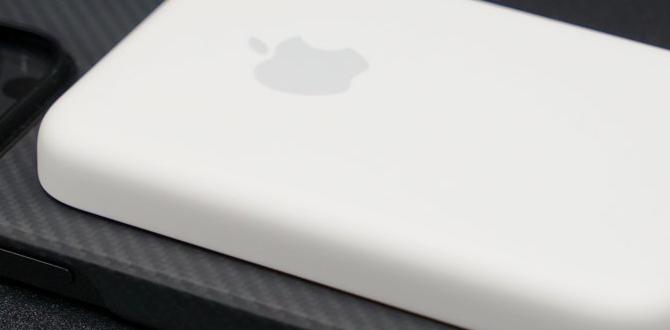Quick Summary: Small battery chargers are compact, versatile power solutions for everyday devices. They’re essential for keeping phones, tablets, and portable electronics charged on the go, offering convenience and reliability when you need power most. Explore their types and how they make life easier.
Small Battery Chargers: Genius & Essential Devices for Modern Life
Ever been stuck with a dead phone just when you needed to make an important call? Or maybe your tablet ran out of juice during a long trip? It’s a common frustration in our always-connected world. Luckily, small battery chargers are here to save the day! These little powerhouses are designed to be super portable and incredibly useful.
They come in many forms, from tiny wall adapters to handy power banks. This guide will walk you through everything you need to know about them. We’ll talk about what makes them so great, how to choose the right one for you, and how to use them safely. Get ready to say goodbye to low battery anxiety!
What Exactly Are Small Battery Chargers and Why Are They a Big Deal?
When we say “small battery chargers,” we’re talking about devices that help recharge batteries in our everyday gadgets. Think about your smartphone, your wireless earbuds, your Bluetooth speaker, or even a small digital camera. All these rely on rechargeable batteries.
These chargers are designed to be:
- Portable: Small enough to slip into a pocket, purse, or backpack.
- Efficient: They get the job done without being bulky or heavy.
- Versatile: Many can charge different types of devices.
The “genius” part is how they solve a big problem – the need for power when you’re away from a wall outlet. The “essential” part is how they’ve become a must-have for anyone who relies on their electronic devices throughout the day.
Your Go-To Guide to Different Types of Small Battery Chargers
Not all small battery chargers are the same. They are designed for different needs and devices. Let’s break down the most common ones:
1. USB Wall Chargers (The Everyday Workhorse)
This is probably the charger that came with your phone. It’s that small cube that plugs into the wall and has a USB port (or an attached cable) for your device.
- How they work: They convert the high voltage from your wall outlet into a lower voltage that your device’s battery can safely accept.
- Why they’re essential: They are the primary way most people recharge their gadgets overnight or while at home or work.
- Key features: Look for wattage (higher wattage usually means faster charging) and the type of USB port (USB-A is common, but USB-C is becoming the standard for faster charging).
2. Power Banks (Portable Power Stations)
Essentially a portable battery you can carry around, a power bank is a lifesaver when you’re away from any power source. You charge the power bank itself when it’s convenient, and then you can use it to charge your phone or other devices on the go.
- How they work: They store electrical energy, much like a rechargeable battery, and can transfer it to your device via a USB cable when needed.
- Why they’re genius: They offer freedom from wall outlets, perfect for travel, camping, long commutes, or just busy days.
- What to look for: Capacity (measured in mAh – milliampere-hours, with higher numbers meaning more charges), number of ports, and charging speed. Some even support wireless charging!
| Power Bank Capacity (mAh) | Number of Full Phone Charges (Approx.) |
|---|---|
| 5,000 mAh | 1 – 1.5 |
| 10,000 mAh | 2 – 3 |
| 20,000 mAh | 4 – 6 |
Note: Actual charges can vary based on the phone’s battery size and the power bank’s efficiency.
3. Car Chargers (Power on the Move)
These plug into your car’s accessory socket (often called a cigarette lighter port) and provide USB ports to charge your devices while you drive.
- How they work: They step down the 12-volt power from your car’s electrical system to a level suitable for charging USB devices.
- Why they’re essential: They ensure your navigation app doesn’t die mid-journey or that you arrive with a working phone.
- Considerations: Look for models with multiple ports if you have passengers, and check for fast-charging capabilities if your devices support it. Some even have built-in voltage displays.
4. Wireless Chargers (Convenience King)
These don’t use cables to connect to your device. Instead, you simply place your compatible phone or accessory on a charging pad or stand.
- How they work: They use electromagnetic induction. A coil in the charging pad generates a magnetic field, and a coil in your device picks up this field, converting it back into electricity to charge the battery.
- Why they’re genius: They eliminate the hassle of fumbling with cables, especially in low light or when you’re tired.
- Things to note: Your device must be wireless-charging compatible, and they are often not as fast as direct cable charging.
5. Battery Cases (Built-in Power)
These are protective cases for your phone that have a built-in battery. They act as both a protective shell and an emergency power source.
- How they work: You charge the case, and it carries its charge. Usually, there’s a button to start the charging process for your phone.
- Why they’re essential for some: They offer the convenience of integrated power without needing a separate device, perfect for those who need extra juice consistently.
- Drawbacks: They can add significant bulk and weight to your phone and may not offer the same capacity as a dedicated power bank.
Choosing the Right Small Battery Charger for Your Needs
With so many options, how do you pick the best one? It really depends on how and where you use your devices.
For the Everyday Commuter or Student:
- A good quality USB wall charger is essential for overnight charging.
- A compact power bank (5,000-10,000 mAh) is perfect for topping up your phone during the day without being too heavy.
- A reliable car charger is a must if you use your car daily.
For the Traveler or Outdoor Enthusiast:
- A high-capacity power bank (20,000 mAh or more) is ideal for extended periods away from outlets. Look for rugged, durable models.
- A solar-powered power bank can be a great eco-friendly option for sunny environments, though charging can be slow.
- A multi-port car charger is useful if you’re on a road trip with family or friends.
For the Tech-Savvy Home User:
- A wireless charging pad or stand offers the most convenience for your primary devices.
- A powerful USB-C wall charger can rapidly charge multiple devices if it has enough ports and wattage.
Consider These Factors When Buying:
When you’re shopping, keep these points in mind:
- Capacity (for Power Banks): How many times do you need to charge your device? A phone battery is typically between 3,000 and 5,000 mAh.
- Charging Speed: Look for “fast charging” capabilities, often indicated by wattage (e.g., 18W, 30W, 65W) or specific technologies like Qualcomm Quick Charge or USB Power Delivery (USB PD).
- Number and Type of Ports: Do you need to charge one device or multiple? Are they USB-A or the newer, faster USB-C ports?
- Brand Reputation and Safety: Stick to well-known brands. Cheaper, unbranded chargers can be dangerous and may not perform as advertised. Look for certifications like UL or CE.
- Durability: If you plan to carry it around a lot, a sturdier build is better.
Safety First: Using Your Chargers Responsibly
While small battery chargers are incredibly convenient, safety is paramount. Batteries store a lot of energy, and faulty chargers or improper use can be risky.
General Safety Tips for All Chargers:
- Use the Right Charger: Always use the charger that came with your device or a reputable replacement. Avoid generic, unbranded chargers, as they might lack safety features.
- Inspect for Damage: Regularly check chargers and cables for cuts, fraying, or bent pins. If you notice any damage, stop using them immediately.
- Avoid Water and Moisture: Never use or store chargers in damp environments, like bathrooms or outdoors in the rain. Water can cause short circuits and electric shocks.
- Proper Ventilation: Chargers can get warm during use. Ensure they have some airflow and aren’t covered by blankets or pillows, which can cause overheating.
- Unplug When Fully Charged (For some types): While many modern devices and chargers have systems to stop charging when full, it’s still good practice to unplug devices when they reach 100% and you won’t be using them for a while.
- Keep Away from Extreme Temperatures: Don’t leave chargers or devices charging in direct sunlight or in a hot car.
Specific Safety for Car Chargers:
Your car’s electrical system can be powerful. Always ensure your car charger is designed to handle the voltage. Reputable car chargers will have built-in protection against overvoltage and short circuits.
A great resource for understanding electrical safety, including battery handling, is the U.S. Department of Energy’s Vehicle Battery Safety page. While it focuses on larger batteries, the principles of careful handling and avoiding shorts are universal.
Power Bank Safety:
Power banks are essentially large batteries. Treat them with care:
- Avoid dropping them or exposing them to physical shock.
- Don’t try to disassemble them; this is dangerous.
- If a power bank starts to bulge, overheat, or leak, stop using it immediately and dispose of it safely.
Maintaining Your Small Battery Chargers for Longevity
A little care goes a long way in making your chargers last.
For Wall Chargers and Car Chargers:
- Gentle Handling: Don’t yank on the cable to disconnect. Grip the plug or the connector.
- Neat Storage: When storing, gently coil cables rather than winding them tightly around the charger. Avoid kinks.
- Keep Ports Clean: Occasionally, gently clean the USB ports on the charger and your devices with compressed air to remove dust and debris.
For Power Banks:
- Regular Charging: Don’t let a power bank sit completely drained for too long. If you’re storing it for an extended period, aim to have it about 50-60% charged.
- Temperature Control: Store them in moderate temperatures, neither too hot nor too cold.
- Use Quality Cables: Just like with wall chargers, use good quality USB cables to connect your devices to the power bank.
The Environmental Impact: Recycling Old Chargers
What do you do with old, broken, or simply outdated chargers? Please don’t just toss them in the trash.
- Electronics Recycling: Many local recycling centers, electronics stores, or even municipalities have designated drop-off points for e-waste, including chargers and batteries.
- Manufacturer Take-Back Programs: Some companies offer programs to take back old chargers for proper recycling when you purchase a new one.
- Why it matters: These chargers contain materials that can be harmful if landfilled, but also valuable components that can be recovered and reused.
Checking out resources like Earth911 (search for “electronics recycling”) can help you find local recycling options for your electronic waste.
Frequently Asked Questions About Small Battery Chargers
Q1: How do I know if a charger is fast enough for my phone?
A1: Look for specifications like wattage (e.g., 18W, 30W or higher) and compatibility with fast-charging standards like USB Power Delivery (USB PD) or Qualcomm Quick Charge. Your phone’s manufacturer will usually list the fastest charging speeds it supports.
Q2: Can I use a power bank to charge my laptop?
A2: Some high-capacity power banks are designed to charge laptops, especially those that use USB-C for charging. You’ll need to check the power bank’s wattage output (often 45W, 65W, or higher) and ensure it’s compatible with your laptop’s charging requirements.
Q3: Is it bad to leave my phone plugged in all night?
A3: Modern smartphones and chargers have built-in battery management systems that prevent overcharging. Once the battery reaches 100%, charging typically pauses. So, while not ideal for long-term battery health, it is generally considered safe and won’t harm the device.
Q4: My charger feels warm. Is that normal?
A4: Yes, it’s normal for chargers to get slightly warm during use. This is a byproduct of converting electricity. However, if it becomes excessively hot to the touch, or if you smell burning, unplug it immediately and stop using it.
Q5: What’s the difference between USB-A and USB-C charging?
A5: USB-A is the older, rectangular connector. USB-C is a newer, oval-shaped connector that is reversible (you can plug it in either way up) and capable of much faster data transfer and higher power delivery for charging.
Q6: How often should I replace my phone charger or power bank?
A6: Chargers and power banks don’t have a set expiry date, but they can degrade over time. If you notice significantly slower charging, if the cable is damaged, or if the power bank holds less charge than it used to, it might be time for a replacement.
Q7: Can I use a travel adapter with my regular charger overseas?
A7: Yes! A travel adapter simply changes the physical shape of the plug to fit foreign outlets. Your charger (if it’s designed for a wide voltage range, usually 100-240V) will still convert the power safely for your device. Always check your charger’s voltage rating.
Conclusion: Powering Your Life, Simply and Safely
Small battery chargers are more than just accessories; they are essential tools that keep our digital lives running smoothly. From the trusty wall adapter that juices up your phone overnight to the robust power bank that saves you when you’re miles from home, these devices offer convenience, reliability, and peace of mind.
By understanding the different types available, choosing the right one for your needs, and always prioritizing safety, you can confidently manage your device’s power. Remember to inspect your gear, use reputable brands, and dispose of old chargers responsibly. With a little know-how, you can ensure you’re always powered up and ready for whatever comes your way.



